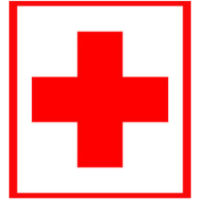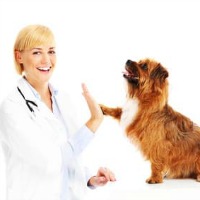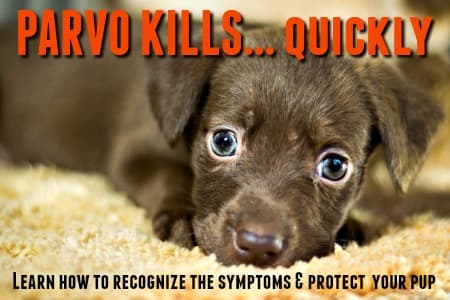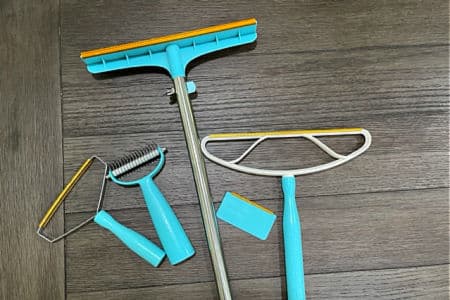FYI: If you buy something through a link on this site I may earn a commission - at NO extra cost to you.
Basic Dog First Aid Supplies
Having some basic dog first aid supplies on hand can be a life-saver if your pet has an emergency.
Although these may not be high on your list of 'new puppy necessities' they're definitely important and every pet-owning home should a first aid kit on hand.
Accidents and/or emergencies can (and do) happen without warning, and puppies aren't known for their common sense - so, it's a good idea to have a well-stocked dog first aid kit on hand - that way you'll have the peace of mind that comes from knowing you're prepared for whatever mischief Fido gets into.
It's also a good idea to make a duplicate (even if scaled-down) dog first aid kit to keep in your car for on-the-go emergencies.
Here is a list of the items I'd recommend including in your kit.
- Digital thermometer
- Emergency thermal blanket
- Soft muzzle
- Scissors
- Tweezers
- Bandages
- Gauze pads
- Antibiotic cream/ointment
- Sterile saline solution or wound cleaner
- Eye and ear washes
- Pain Medication
- Benadryl Tablets
- Veterinary handbook
- One use ice packs
- Cotton balls/pads
- Pedialyte
- Small, clean washcloths
- Surgical glue
Dog First Aid Supplies List
It's a good idea to put together your own supplies because there aren't a lot of pre-made dog first aid kits on the market, and the ones that are there often don't contain everything you need... or they have supplies that are more suitable for people than pets.
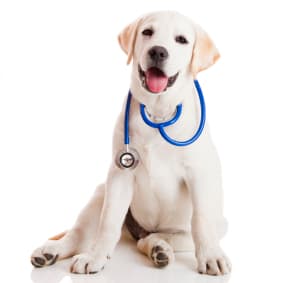
Luckily, it's not too difficult to gather all the stuff you need to keep your pup safe! Here's a list of the MOST IMPORTANT items you need (including tips for choosing and using them), then a bit further down this page we'll take a look at some other products that I'd recommend, even though they're not absolutely essential.
DIGITAL THERMOMETER
A rectal thermometer is the way most vets take a dogs' temperature, and these are both inexpensive and easy to find. It can be a little tricky to take Fido's temperature rectally if you haven't done it before, and you need two people to do it safely.
A thermometer with a flexible-tip is the easiest and safest to use, but regardless you need to be gentle and careful when inserting it into the rectum.
If you'd rather not go this route, then the MINDPET-MED clinical pet thermometer might be just what you need. It takes an accurate reading within seconds when held close to your pet's ear.
Normal canine body temperature is between 100.5 & 102F.
If your dogs temperature is higher than this it generally indicates a fever (usually as a result of infection). In hot weather 106F or above can mean life-threatening heatstroke.
A temp of 99F or below can mean your pup is going into shock...at the very minimum he's seriously chilled.
EMERGENCY THERMAL BLANKET
It's important to keep an injured animal warm, because if they go into shock it triggers a sudden severe drop in body temperature.
Emergency thermal blankets are light and portable, and an important item in your dog's first aid kit (and in any human first aid kit as well!).
SOFT MUZZLE
If your dog is injured and/or in pain, he's could easily snap or bite at you - even if normally he's the most docile pet in the world.
He's hurt and afraid, so it's understandable, but you need to be able to help him without risking getting hurt yourself. A soft muzzle will help you do this. Try Quick Fit Nylon Dog Muzzle, which comes in a range of sizes.
There are also plenty of other designs/styles including those specifically made for flat-nosed breeds such as Pugs and Bulldogs.... Adjustable Mesh Dog Muzzle for Bulldogs and Short Nose - Flat Faced Breeds
TIP:If you don't have a muzzle handy and it's an emergency, you can use a piece cut from a leg of your panty-hose!
SCISSORS
Blunt-tipped, stainless steel is best. They need to be sharp enough to gut bandages, gauze and tape as well as trim fur from around any injuries.
TWEEZERS
Flat, slant-tipped designs give you a better grip. These are good for removing splinters, ticks, thorns from paw-pads etc.
BANDAGES
A bandage hold gauze pads in place, covers stitches, wraps joints... and so much more. But regular bandages can get caught on your dog's fur and cause him discomfort or pain.
Luckily there's 3M Vetrap Bandage Tape which is especially designed for veterinary use and won't cause the same problems.
If your dog is inclined to chew at his dressing, you could try PetFlex No Chew which has a bitter taste.
For minor wounds try R-7 Liquid Bandage Spray which gives a quick, waterproof seal over small injuries and is also bitter-tasting to discourage licking.
GAUZE PADS
Regular gauze pads from the pharmacy or superstore are fine. 3" x 3" is a good size, but an assortment is even better.
ANTIBIOTIC CREAM/OINTMENT
Any OTC antibiotic cream or potion will work just fine.
STYPTIC POWDER, GEL OR PEN
This is usually used to stop any bleeding when a dog's nails are cut too short and the quick is 'nipped', but it is also a good way to stop minor cuts and nicks from bleeding. Miracle Care Kwik Stop Styptic Powder is a popular choice.
STERILE SALINE SOLUTION OR WOUND CLEANER
You can use a sterile saline solution (even contact lens rinse can work if you don't have anything else to hand in an emergency) to wash foreign objects out of your pets eye, or to clean cuts and abrasions.
A product that fights infection and speeds healing is even better for cleaning injuries than saline is Vetericyn Plus All Animal Wound & Skin Care. It's amazing and works on all sorts of cuts, scrapes and even sore areas or hot-spot inflammation from allergies and such.
EAR & EYE WASHES
Vetricyn also make safe and gentle Canine Eye Wash Liquid, and Canine Ear Rinse Liquid.
PAIN MEDICATION
For minor pain, short-term pain you can use Aspirin, but not ANY old aspirin. Check out this page Aspirin For Dogs for more info. and correct dosage.
If your dog is in a lot of pain, or has had surgery, there are other safe and effective pain-killers for dogs that your veterinarian can prescribe.
BENADRYL TABLETS
These work well to reduce minor swelling or hives that result from an allergic reaction. ONLY GIVE BENADRYL IN TABLET FORM TO YOUR DOG, the liquid contains alcohol which is bad for him, and sometimes even toxic.
The correct dosage is 1/2mg per pound of bodyweight - given every 8 hours.
*If your pup has a lot of swelling around the face, head or mouth this can cause him to have difficulty breathing or become dizzy, disoriented or weak and needs emergency vet treatment immediately.
A GOOD VETERINARY HANDBOOK
Although this is appearing at the bottom of the list here, it's actually a very important item in your dog first aid kit! A good animal first aid/veterinary handbook is an essential.
The Dog Owner's Home Veterinary Handbook or The First Aid Companion for Dogs & Cats (Prevention Pets) are both good choices.
Additional dog first aid Kit items
The above items are what I'd consider to be essential in any basic first aid kit for dogs. But there are few other things that I'd also recommend adding. These include:
- One-use ice packs
- Cotton balls/pads
- Eye dropper
- Pedialyte
- Several small, clean washcloths
- Surgical glue
Once you've got all your veterinary/medicinal supplies in place, it's time to assemble the first aid kit itself.
I'd recommend buying a sturdy plastic toolbox (the kind that has expandable, pull-out trays and a carrying handle) is ideal. So are fishing tackle boxes or the kind of boxes designed to hold craft equipment.
If possible get two boxes and stock them both, that you have one ready to put in your car right away.
Whatever type of box you choose, be sure to label it clearly on the outside (in permanent marker) with the following information:
ASPCA Animal Poison Control Center
1-888-426-4435
National Animal Poison Control Center
1-900-680-0000
or
1-800-548-2423
PLUS....
- Your pet's name
- Your veterinarian's telephone number
- Telephone number of the closest 24 hour animal hospital/clinic
- Poison Control Center Hotline number
- Your own name, address and telephone number
It's a good idea to also check with your veterinarian for extra advice, he/she may have other suggestions that you'll find helpful.
But please, always remember that these basic dog first aid supplies are for emergency use only and do not take the place of veterinary care.
In the event of illness or accident you should ALWAYS TAKE YOUR PUP TO THE VETERINARIAN'S OFFICE OR NEAREST EMERGENCY PET CLINIC, as soon as possible!
you might also like...
- Home
- Dog Health Information
- Basic Dog First Aid Supplies
FTC Disclosure: Some pages on this site contain affiliate links. I may earn on qualified purchases.
